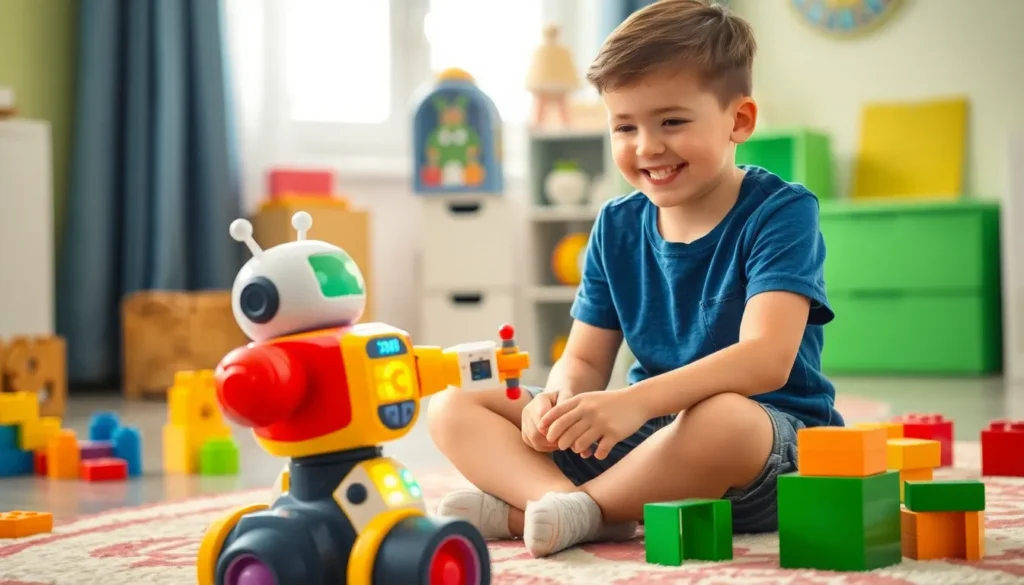Table of Contents
ToggleIn a world where screens dominate playtime, interactive toys are shaking things up and bringing back the fun! These clever gadgets don’t just sit there looking pretty; they engage kids in imaginative adventures while sneaking in a bit of learning. Who knew that a toy could be a teacher, a playmate, and a ticket to creativity all rolled into one?
Overview of Interactive Toys
Interactive toys have gained popularity as engaging options for children in a technologically advanced environment. By blending play with education, these toys inspire creativity and foster learning. Children can explore various concepts through hands-on experiences, making learning enjoyable.
Manufacturers design these toys to cater to different age groups and developmental stages, ensuring broad appeal. Examples include programmable robots, talking dolls, and building sets with smart technology. Such toys often promote essential skills like problem-solving, critical thinking, and social interaction.
Safety plays a crucial role in the development of interactive toys. Companies prioritize quality materials and adhere to strict safety standards to protect children during play. Parents can feel confident in choosing these products, knowing that safety is a top consideration.
Technology continues to evolve, further enhancing the capabilities of interactive toys. Integrations with apps and online platforms provide additional layers of engagement. This connectivity allows children to interact with their toys in innovative ways, expanding the potential for learning and fun.
The benefits of interactive toys extend beyond the individual. They encourage collaborative play among peers, promoting teamwork and cooperation. As children share experiences, they develop communication skills and empathy.
Interactive toys are more than just novelties; they serve as essential tools for holistic development. With a combination of fun and educational value, these toys have cemented their place in modern childhood.
Types of Interactive Toys

Interactive toys come in various forms, with each type designed to engage children differently. They fall into two main categories: educational and entertainment.
Educational Interactive Toys
Educational interactive toys focus on teaching essential skills while keeping children engaged. These toys often integrate lessons in math, language, and science through interactive play. For instance, coding robots help kids grasp programming basics by allowing them to create commands through simple actions. STEM-based building kits encourage problem-solving and critical thinking as children construct models while adhering to certain principles. Other examples include talking books that develop literacy by making reading fun and engaging. Many of these toys also promote social skills through collaborative activities, helping children learn communication and teamwork while playing.
Entertainment Interactive Toys
Entertainment interactive toys prioritize fun while incorporating an element of interactivity. Products like smart dolls respond to children’s actions, offering companionship and encouraging imaginative play. Electronic board games provide a modern twist on classic games, merging technology with traditional gameplay. Additionally, augmented reality toys turn surroundings into interactive experiences, capturing children’s attention and sparking their creativity. These toys often feature customizable options, allowing kids to influence gameplay or storylines. Together, entertainment interactive toys create opportunities for laughter and joy while subtly supporting cognitive development.
Benefits of Interactive Toys
Interactive toys provide numerous advantages that significantly impact children’s growth. These toys stimulate various areas of development, including cognitive and social skills.
Cognitive Development
Cognitive development thrives through engaging interactions with interactive toys. Children enhance problem-solving abilities while exploring programmable robots, which encourage logical thinking. Smart building sets foster creativity and spatial awareness, allowing kids to experiment and design. Educational toys incorporate math lessons and language skills through fun activities, making learning enjoyable. Relevant studies show that children using interactive toys demonstrate improved memory and understanding of complex concepts. Engaging with these toys also nurtures critical thinking, promoting a mindset geared toward exploration and innovation. Overall, cognitive skills benefit significantly from play that challenges and stimulates young minds.
Social Skills Enhancement
Social skills development flourishes when children engage with interactive toys in group settings. Collaboration emerges as kids work together on coding robots or electronic board games, cultivating teamwork. Sharing toys provides opportunities for communication, as children express ideas and negotiate play scenarios. Playmates learn empathy while interacting with dolls that respond to emotions, reinforcing awareness of others’ feelings. Research highlights that shared play experiences improve social cognition among peers. Additionally, these toys encourage turn-taking and patience, essential components of effective communication. Consequently, social skills receive a notable boost through the cooperative nature of interactive play.
Considerations When Choosing Interactive Toys
Selecting the right interactive toy involves assessing various factors. Parents and caregivers should consider age appropriateness and safety features to ensure a suitable play experience.
Age Appropriateness
Choosing toys that match a child’s developmental stage enhances their engagement and learning. Limits exist in terms of complexity and safety, influencing how children interact with toys. For example, a toy designed for toddlers focuses on basic skills like identifying shapes and colors. Alternatively, toys for older children incorporate advanced problem-solving features and critical thinking challenges. Reviewing labels that recommend age ranges helps in making informed choices. Additionally, educators and child development specialists often recommend toys that encourage exploration and curiosity at each stage.
Safety Features
Safety features are crucial in the selection of interactive toys. Companies prioritize the use of high-quality, non-toxic materials in their designs. Many interactive toys undergo rigorous testing to comply with safety standards set by agencies like the Consumer Product Safety Commission. For instance, rounded edges and small part exclusions reduce choking hazards. Furthermore, battery-operated toys include secure battery compartments to prevent access. Ensuring the presence of safety certifications provides peace of mind for caregivers concerned about potential hazards.
Interactive toys represent a significant evolution in playtime, merging fun with valuable learning experiences. They not only captivate children’s imaginations but also nurture essential skills that support their overall development. As technology advances, these toys continue to adapt, providing innovative ways for children to engage and learn.
Parents and caregivers can feel confident in choosing interactive toys, knowing they promote cognitive growth and social skills. By selecting age-appropriate and safe options, they can ensure a rich play experience that balances entertainment with education. Ultimately, interactive toys are more than just playthings; they are instrumental in shaping the future of childhood learning and creativity.







